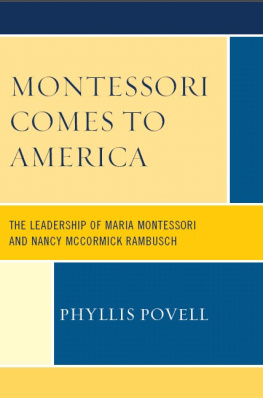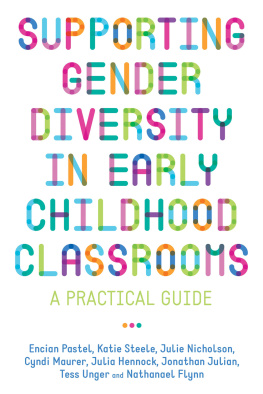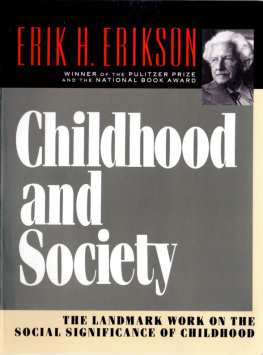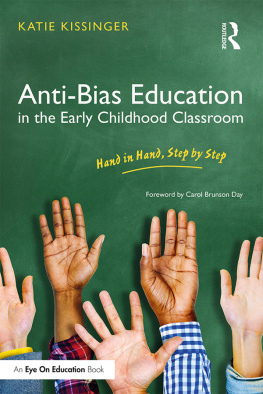Theories of Childhood
An Introduction to Dewey, Montessori, Erikson, Piaget, and Vygotsky
Second Edition
Carol Garhart Mooney

Published by Redleaf Press
10 Yorkton Court
St. Paul, MN 55117
www.redleafpress.org
2000, 2013 by Carol Garhart Mooney
All rights reserved. Unless otherwise noted on a specific page, no portion of this publication may be reproduced or transmitted in any form or by any means, electronic or mechanical, including photocopying, recording, or capturing on any information storage and retrieval system, without permission in writing from the publisher, except by a reviewer, who may quote brief passages in a critical article or review to be printed in a magazine or newspaper, or electronically transmitted on radio, television, or the Internet.
First edition published 2000. Second edition 2013.
Cover design by Jim Handrigan
Author photo by Jeff Klapes
Excerpt on page 56 is from Linking Brain Principles to High-Quality Early Childhood Education, Exchange 202 (Nov/Dec): 811, by Stephen Rushton and Anne Juola-Rushton. Copyright 2011 Exchange Press, Inc. Reprinted with permission.
Photograph of Maria Montessori on page 35 Hulton-Deutsch Collection/CORBIS
Photograph of Erik Erikson on page 53 Ted Streshinsky/CORBIS
ISBN 978-1-60554-248-5 (e-book)
For Jeannette Stone, mentor and friend
Contents
THIS BOOK WAS WRITTEN LATE at night and on weekends, sandwiched between family and work life. It bears my name only, but, as Im sure it is with most books, this one was a group effort.
To begin with, the thinking and framework for this review of early childhood theory was a collaborative effort with my friend and colleague Jeannette Stone. It was always our project!
The manuscript was refined thanks to the computer skills and energy of Marguerite Shanelaris. I am grateful to so many colleagues at New Hampshire Head Start and the New Hampshire Child Care Association for sharing their stories and classrooms with me. When I grew weary, I was forced back on track by the special friendship and support of Jay Munson, Sue Cloutier, and Pat Meattey. I am grateful to my many students at the Granite State College and the New Hampshire Community Technical Colleges who convinced me of the need for the book.
I appreciate the opportunity Redleaf Press has given me to bring the seed of this book to fruition. My editor, Beth Wallace, convinced me I could get it done and offered humor and support along the way.
Finally, I thank my children:
Sean, for decades of support of my writing and the book on Vygotsky.
Brian, for offering humor when I needed it and for forcing me to enter the computer age.
Tom, for downloading the research and late-night computer assistance.
Erin, for accepting a preoccupied mom and loving me anyway.
Were done!
Carol Garhart Mooney
Manchester, New Hampshire June
2000, updated July 2012
FIFTEEN YEARS AGO WHEN I BEGAN WORK on the first edition of Theories of Childhood, I knew it was a good idea. I had been a practitioner and college instructor for many years and knew that parents, child care teachers, providers, and students all increasingly struggled with what to do with the children.
I never expected the response to the book that I have enjoyed in the past decade. At conferences and training sessions, I am frequently approached by students who say they never got theory until they were forced to read my book in college. I have appreciated feedback from the many community college, university, and graduate school instructors who thank me for creating a usable text for beginners.
It is interesting that I have received comments and letters from many readers for whom English is not their native language. These practitioners have thanked me for helping them transition to caregiving in the United States. It is both humbling and gratifying to think that my own theory and practice struggles have helped colleagues to frame both for their daily work with children.
It is also interesting to me that there was some question at the time about using the Margaret Mead quote in the introduction. Objections were twofold. The editor did not like that the quote was from 1963 (still relevant?). And the source (Redbook magazine), we would mostly agree, is not a credible research tool for writing a textbook. I was new to the world of writing textbooks, and to me, Margaret Mead was credible wherever and whenever she made comments about the human condition.
Today, with over 75,000 copies in circulation, I am more confident about Meads words and my insistence that we use them. The teacher who most affected me in my undergraduate years made a similar comment to Meads in his existential philosophy course. This course, he was known to say, attracts those who want a podium. If you have something to say... it best be said in a way that my great-aunt Gertrude, who has only a third-grade education, can read it and understand it. A good rule of thumb for sharing important information is to use simple, direct language.
The mistake I made was assuming that the piece of my contract that said I would be willing to update as needed would ever be called in. It is a source of some humor both at Redleaf and my house that I had quite intentionally chosen theorists who were quite dead. I figured if I was able to state the theorists perspective in a clear, straightforward manner, offering classroom examples... what more could be done? Its not like there would be additional work to discuss.
Today this seems extraordinarily naive to me. The 1990 National Teacher of the Year, Janis T. Gabay, told audiences, I offer my students as many ideas as I can by showing them through literature that there is nothing that has not already been felt, experienced, or thought, but much to be discovered in a new way (Council of Chief State School Officers [CCSSO], accessed 2012).
The technological changes alone to our daily lives in the past decade are astounding. Then there are changes in science, medicine, educational psychology, womens studies, and family studies. Over the past thirty years, children have been driven from the natural world by the advances of technology, fear (for example, stranger danger, natural disasters), and even classroom messages meant to raise their concerns about the worlds future (for example, global warming). This phenomenon has been termed nature-deficit disorder. In his book Last Child in the Woods, author Richard Louv writes, Nature-deficit disorder describes the human costs of alienation from nature, among them: diminished use of the senses, attention difficulties, and higher rates of physical and emotional illnesses (2008, 36). Additionally, if children are not given opportunities to explore and embrace the natural world, who will take care of it in the future? And a decade ago, most of us didnt pay much attention to the ethnocentric (characterized by or based on the attitude that ones own group is superior) nature of many of our considerations regarding children and families in the United States. We interpret all learning with a much broader lens as we consider culture, changing times, the importance of time in nature, and practices we didnt know existed even a decade ago.
It is this spirit of discovering in a new way and interpreting through a broader lens and application to a new generation of young children that I offer this second edition of Theories of Childhood. I hope to maintain the simplicity and directness readers have appreciated while taking a fresh look at our theoretical foundations in an increasingly rapidly changing world.







